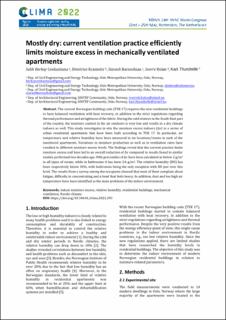| dc.contributor.author | Coskuntuna, Salih Berkay | |
| dc.contributor.author | Kraniotis, Dimitrios | |
| dc.contributor.author | Barnoshian, Siavash | |
| dc.contributor.author | Holøs, Sverre Bjørn | |
| dc.contributor.author | Thunshelle, Kari | |
| dc.date.accessioned | 2022-10-04T13:08:41Z | |
| dc.date.available | 2022-10-04T13:08:41Z | |
| dc.date.created | 2022-09-28T08:05:18Z | |
| dc.date.issued | 2022 | |
| dc.identifier.isbn | 978-94-6366-564-3 | |
| dc.identifier.uri | https://hdl.handle.net/11250/3023644 | |
| dc.description.abstract | The current Norwegian building code (TEK 17) requires the new residential buildings to have balanced ventilation with heat recovery, in addition to the strict regulations regarding thermal performance and airtightness of the fabric. During the cold winters in the South-East part of the country, the moisture content in the air outdoors is very low and results in a dry climate indoors as well. This study investigates in-situ the moisture excess indoors (Δv) in a series of urban residential apartments that have been built according to TEK 17. In particular, air temperature and relative humidity have been measured in six locations/rooms in each of the monitored apartments. Variations in moisture production as well as in ventilation rates have resulted in different moisture excess levels. The findings reveal that the current practice limits moisture excess and have led to an overall reduction of Δv compared to results found in similar studies performed two decades ago. 90th percentiles of Δv have been calculated as below 2 g/m3 in all types of rooms, while in bathrooms it has been 2.6 g/m3. The relative humidity (RH) has been respectively below 30%, with bathrooms being the only exception with RH just over this level. The results from a survey among the occupants showed that most of them complain about fatigue, difficulty in concentrating and a head that feels heavy. In addition, dust and too high air temperature have been identified as the main problems of the indoor environment. | en_US |
| dc.language.iso | eng | en_US |
| dc.publisher | TU Delft Open | en_US |
| dc.relation.ispartof | Proceeding of the The 14th REHVA HVAC World Congress 22nd-25th May, Rotterdam, The Netherlands | |
| dc.relation.ispartof | The 14th REHVA HVAC World Congress. Clima 2022 | |
| dc.rights | CC BY 4.0 | * |
| dc.rights.uri | http://creativecommons.org/licenses/by/4.0/ | * |
| dc.subject | Indoor moisture excess | en_US |
| dc.subject | Relative humidity | en_US |
| dc.subject | Residential buildings | en_US |
| dc.subject | Mechanical ventilation | en_US |
| dc.subject | Nordic climate | en_US |
| dc.title | Mostly dry: current ventilation practice efficiently limits moisture excess in mechanically ventilated apartments | en_US |
| dc.title.alternative | Mostly dry: current ventilation practice efficiently limits moisture excess in mechanically ventilated apartments | en_US |
| dc.type | Chapter | en_US |
| dc.type | Peer reviewed | en_US |
| dc.description.version | publishedVersion | en_US |
| dc.rights.holder | © 2022 The authors | en_US |
| dc.subject.nsi | VDP::Teknologi: 500 | en_US |
| dc.identifier.doi | 10.34641/clima.2022.293 | |
| dc.identifier.cristin | 2056123 | |
| dc.relation.project | Norges forskningsråd: 308819 | en_US |
| cristin.ispublished | true | |
| cristin.fulltext | original | |

